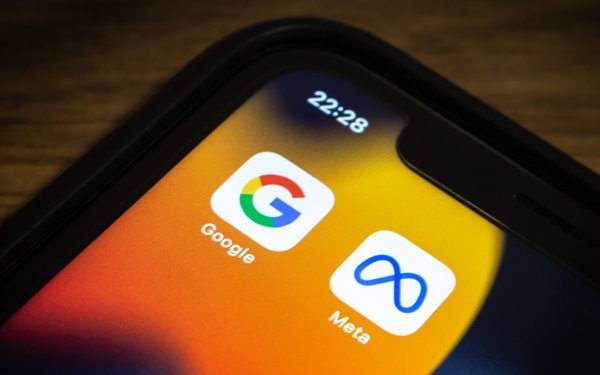Duopoly's Ad Dominance Continues To Erode: U.S. Share Slipped Below 50% In 2022
- by Karlene Lukovitz @KLmarketdaily, January 3, 2023

Google and Meta’s long dominance in global advertising continues to erode, with their combined ad revenues slipping below half of total U.S. digital ad revenue in 2022, for the first time since 2014, according to projections by Insider Intelligence.
The so-called “duopoly” drew a combined 48.4% of U.S. digital ad revenue last year, including 28.8% for Alphabet’s Google (up slightly year-over-year) and 19.6% for Meta’s Facebook, Instagram, Messenger and WhatsApp — compared to peak shares of 34.7% and 20%, respectively, or 54.7% combined, for Google and Meta in their peak year of 2017.
That was the fifth year of combined share decline for the companies. Google’s share is projected to decline to 26.5% this year, and the forecast for 2024 calls for a combined share of 43.9% (26% for Google, 17.9% for Meta).
On a global basis, the duopoly’s share dipped by a percentage point in 2022, to 49.5%.
Meta’s advertising growth has been more affected by diminished ad targeting capabilities as a result of Apple’s iOS opt-in privacy policy change than Google’s, since Google uses search-generated user intent data for targeting, rather than app and web tracking data.
TikTok’s rapid user and advertising ramp-up has hit Meta hard. But with a currently comparatively small ad revenue share, TikTok is still expected to be behind Google, Meta, Amazon and Microsoft/LinkedIn among U.S. digital advertising leaders as of 2024, with a projected $8.6 billion in ad revenue.
Still, the competition’s impact is adding up.
Amazon, which built its ad revenue to more than $31 billion between 2015 and 2021 and strengthened its No. 3 position last year, with an estimated $38 billion, is the biggest competitive threat for both Google and Meta. Amazon’s U.S. digital share was 11.7% in 2022, and is projected at 12.4% in 2023 and 12.7% in 2024.
This year, Google and Meta’s ad-revenue growth are projected at 3% and 5%, respectively, versus double-digital growth for Amazon (19%). Other tech companies, while still having relatively small shares of U.S. digital ad revenue, are projected to see even greater percentage growth. Examples include Walmart (42%), Instacart (41%), TikTok (36%), Spotify (30%) and Apple (26%).
Apple’s ad revenues have grown from about $2 billion to $7 billion since 2018, for a 1.2% share globally, and with a major ramp-up underway to achieve its declared goal of “redefining advertising” in a privacy-centric environment, it could reach $30 billion by 2026, by some estimates. Apple has already launched a competitor to Google Maps, an iPhone search function.
The retail media networks of Walmart, eBay, Etsy and Instacart grabbed a combined U.S. digital ad share of 1.4% in 2022, according to Insider Intelligence.
Microsoft/LinkedIn continue to build their advertising businesses, and streaming platforms are also beginning to make a dent in the marketplace. Roku, Hulu, Pluto TV, Paramount+, Tubi and Peacock pulled a combined 3.6% share in the U.S. in 2022 — and the new ad-supported tiers of Disney+ and Netflix bound to attract significant advertising dollars this year and beyond.
Still, while digital ad growth will slip from 10.7% in 2022 to 9.2% this year, per GroupM, digital will claim nearly two thirds of projected total U.S. ad spending. And it is always possible that innovations will actually grow the overall digital advertising expenditures pie in the months or years ahead.


